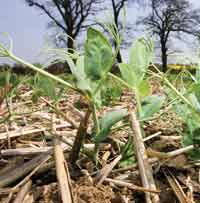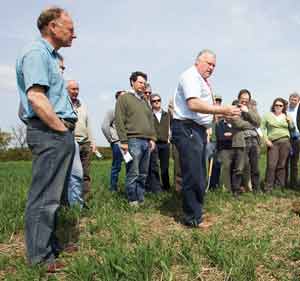Closing the slot key to direct drill success

The prospective No-Till Alliance held its first meeting at Simon Cowell’s Essex farm. Mike Abram reports
| NOW WATCH THE VIDEO |
|---|
| Jim Bullock explains more about the No-Till Alliance on our FWi videos from the day. See that, and three other videos taken from the day, including Steve Townsend explaining why small areas of host farmer Simon Cowell’s second wheat might have suffered from slug damage, and to see the amazing response from compost in his oilseed rape. |
Being unable to close the slot or gouge after the drill was one of the main reasons for direct drilling to fail, Steve Townsend told growers at a farmer-organised meeting for a prospective No-Till Alliance growers club.
“The main issue is not having enough tilth to close the slot. It leads to lots of issues, including slug damage.”For growers using direct drill establishment, cultivation to produce more tilth wasn’t an option, the key was to build soil organic matter levels, he said. “I’m a big fan of chopping all straw residues on farm. It is an easy form of carbon. Carbon equals soil organic matter equals tilth,” he explained. “So don’t sell your straw.”
| MORE ON NO-TILL AND DIRECT DRILLING |
|---|
VIDEO: Eight direct drills head-to-head STORIES: Direct drilling kit at LAMMA 2009 |
The advantages of not removing straw included helping reduce compaction, improving water retention and suppressing weeds. But there were downsides to straw, he acknowledged.
“Its tilth and soil fertility value is positive, but it is a great haven for slugs and some people say it has an effect on crop germination.”
That was due to something called allelopathy, he said. “Allelopathy is the effect of organic acids from the breakdown of organic residues on the germination of following crops.
“It can make crops look sick – it affects tillering and rooting.”
The key to avoiding it was to preventing seed-to-residue contact, he said. Drill choice probably had the greatest impact, with tine drills brushing the residues aside, rather than “hair-pinning” it into the slot as tended to happen more with disc drills.
 |
|---|
| Slugs had caused a few thin patches in Simon Cowell’s (far left, nearest to camera) second wheat, Steve Townsend (centre) believed. Drilling deeper through the higher amounts of trash might alleviate the problem, he said. |
Rotation could also play a part. It was well known that oats didn’t like following oats, and broadleaved weeds could be suppressed after rye cover crops, but more research was needed, he said. “We need to know more about what happens to our crops after certain crops.”
Allelopathy could also have a positive impact on blackgrass, he said. “The acids also affect weed germination, especially small-seeded weeds, if you leave the straw on or near the surface. It is why some farmers see a reduction in blackgrass when they direct drill.”
Sterile brome was the main grassweed threat for no-till, he believed. “It has a relatively large seed, which is relatively unaffected by organic acids, and it can come through straw.
“But its weakness is that it won’t germinate in ultraviolet light, so get it into the dark.”
Cultivation was the obvious method, but direct drillers could employ cover crops or use the straw residue to help achieve the objective of getting the brome to germinate so it could be taken out prior to drilling.
Spring cropping could also help with brome, he suggested. “If you leave stubble over winter you have the chance to break its lifecycle.”
Slug issues in direct-drilled crops were directly related to a lack of tilth, Mr Townsend said. In that situation even rolling didn’t really help. “Without enough tilth you cannot close the slot even when you roll, which is why slugs can eat the crops.”
That meant it might be worth cultivating in the early years to improve tilth levels, he suggested.
When there was enough tilth to make rolling effective it was imperative to use a heavy roller, he stressed. “It needs to exert at least 0.6t/m but no more than 0.8t/m.”
KNOW SOIL BIOLOGY FOR NO-TILL |
|---|
| Understanding soil biology and fertility was extremely important when direct drilling, Robert Plumb of Independent Soil Services told growers. In particular the balance between calcium and magnesium was critical to having the right soil structure for beneficial bacteria and bugs to live, he said. The two were a bit like sand and cement. “If you have too much cement, or magnesium, the soils will crack wide open, and become tight and anaerobic. Too much sand (calcium) and the soil fragments, becomes too crumbly and dries out too quickly.” Ideally, the soil should contain 2000-3000ppm of calcium and 200-300ppm magnesium, he said. Achieving the right balance would allow beneficial aerobic bacteria to thrive in the topsoil, where 80% lived. “It is a good reason not to plough – don’t turn them down into the soil. You need them in the topsoil to break straw down and build into humus.” Humus glued soil particles together to give it its spongy feel, allowing it to be rolled without causing compaction, he said. It also helped soils carry higher amounts of water, which protected against soil erosion and other environmental issues. Aerobic bacteria also provided plants with nutrients and protected against diseases. “By feeding your soil you’re putting biological plant food into the soil. And the plant itself is a sugar factory, excreting large amounts of sugars into the soil, which in turn feed the bacteria.” That symbiotic relationship was vital to getting soils to work more effectively, he said. “And that will give a better chance of getting these higher yields we all want.” |
STRONG GROWER BACKING FOR ALLIANCE | ||
|---|---|---|
The Alliance would be run by growers for growers, Jim Bullock said introducing the day. “We need to develop this ourselves. There is a lot of data from other countries, but it is not all applicable to our climate or conditions. And we cannot expect drill manufacturers or agrochemical companies to do all the research we need. It would be a bit like turkeys voting for Christmas.” The idea would be to share the successes and failures of growers using no-till techniques, he said. “Particularly the failures. We need to learn from our mistakes and to identify the limitations of no-till systems, and then develop techniques suitable for our soils and climate.”
If enough funding could be attracted, the Alliance could carry out specific research, he hoped. “For example, to find out why some crops go through that embarrassment stage after establishing when they look awful into the spring.” The next steps after the success of the first meeting would be to form a farmer-based advisory committee, communicate with interested growers what the Alliance would do, and to set a membership fee. “We’re thinking about offering members an annual meeting, email newsletters, ways to contact other local members, and eventually a website, with a members’ only area to share information.” |

